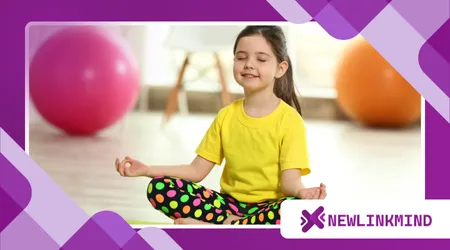Quiet Time: Doing Yoga at Home with Kids Around

Anúncios
Quiet Time. Many parents feel the pressure to have a perfect, uninterrupted yoga session. This idea is a myth. The truth is, a perfect practice doesn’t exist, especially not for parents.
A more realistic goal is a flexible and adaptable one. The true purpose of yoga is not about achieving an ideal pose. Instead, it’s about finding balance and peace.
Your practice can be a few minutes, or it can be a full hour. It’s about what you need at the moment. Don’t let the pursuit of perfection stop you from starting.
Creating Your Sanctuary: Space and Mindset
Carving out a physical space for your practice is essential. This can be a corner of your living room or even a small mat in the bedroom. Just make it a dedicated spot.
A dedicated space helps signal to your mind and body that it’s time to focus. It’s your sanctuary, a place where you can be present.
Anúncios
The most important part of this sanctuary is your mindset. Shift your perspective from seeing interruptions as failures to seeing them as part of the practice itself.
Embracing the chaos is a form of mindfulness. It teaches you to stay centered amidst distractions. This is the essence of a truly advanced practice.
Smart Strategies for Doing Yoga with Kids Around
Let’s explore some actionable strategies to make your practice work. These ideas will help you find a new rhythm.
Anúncios
One effective approach is to involve your children. They can be your little yoga partners. Kids love to mimic, and this turns your practice into a fun activity for them.
You can also use a “sacred mat” rule. Teach your kids that when you are on your mat, it is your special, quiet space. They can watch, but they shouldn’t climb on you.
Read here: How to Track Your Progress with Yoga at Home
Another strategy is the “early bird” approach. Waking up 15 or 20 minutes before your kids can be a game-changer. This small window can provide the uninterrupted time you crave.
Or, consider practicing during their nap time. This can be a more predictable window of stillness. It’s an opportunity for a deeper, more restorative practice.
The goal isn’t to eliminate interruptions, but to manage them. This approach makes your practice more resilient and sustainable in the long run.
A powerful tool is to explain to your kids what you are doing. Using simple terms helps them understand why this time is important to you. For example, “Mommy is taking some slow breaths to feel calm.”

The “Sprinkle” Approach to Yoga
Think of your yoga practice not as one big cake, but as small sprinkles. Instead of waiting for a long block of time, you can do short sessions throughout the day.
A 5-minute stretch in the morning, a few deep breaths while your kids are playing, and a short meditation before bed. These little moments add up.
Read more: Easy Yoga Poses to Relieve Back Pain at Home
This approach makes yoga accessible and non-intimidating. It removes the pressure of needing a perfect 60-minute window. Every little bit counts.
You’re a busy parent, so your yoga practice must fit into your life, not the other way around. This sprinkle approach ensures you get some form of practice in every single day.
The Unspoken Benefits for Kids
When children see their parents practicing yoga, they learn a valuable lesson. They see you prioritizing your well-being, which is a powerful example for them.
They learn about self-care and emotional regulation. This is a crucial life skill they will carry with them. You’re not just doing yoga for yourself; you’re teaching them.
You’re also modeling resilience. When your kids see you stay calm despite distractions, they learn how to handle their own frustrations.
Let’s look at some of the key benefits for both you and your children in a simple table.
| Benefits for Parents | Benefits for Children |
| Reduced stress and anxiety | Learn emotional regulation |
| Increased flexibility and strength | Develop body awareness |
| Enhanced mental clarity | See self-care modeled |
| Improved sleep quality | Learn focus and presence |
| Greater patience and resilience | Learn to respect boundaries |
This shared practice can be a bonding experience. It creates a special connection and shared memories. It’s more than just an exercise.
Managing Expectations and Finding Your Joy
It’s crucial to manage your expectations. Your practice will not always be peaceful. Sometimes, it will be messy and loud, and that’s okay.
The joy of practicing yoga with kids is in the imperfection. It’s in the real, unfiltered moments of life. This is where the true learning happens.
Consider the analogy of a river. A river doesn’t flow in a straight line; it meanders around rocks and obstacles. It finds its way forward, adapting to the landscape. Your yoga practice should be like this.
Just like a river, you can navigate the obstacles of parenthood. The interruptions are just part of the flow.
Check this out: 5 Common Mistakes in Morning Meditation (And How to Fix Them)
How can you truly find inner peace if you can’t find it in the middle of your own life? It’s a question worth asking.
Research published in the Journal of Pediatric Psychology in 2023 showed that family-based mindfulness activities, including yoga, can significantly reduce parental stress and improve children’s emotional regulation. This isn’t just about feeling good, it’s about real, measurable benefits.
Finding Quiet Time is less about finding a silent room and more about finding a quiet moment within yourself. That’s the real challenge and the real reward.

The “Lion’s Breath” Moment
Imagine this: you’re trying to do a Downward Dog, and your toddler decides it’s the perfect time to crawl underneath you. This is an opportunity.
Instead of getting frustrated, you can turn this into a game. You can tell them to make a “lion’s roar” with you. You take a big breath in, and on the exhale, you stick your tongue out and roar like a lion.
This is a fun way to release tension for both of you. It shifts the energy from frustration to playfulness. This is a real-world example of integrating your practice into your life.
Another example: you’re trying to meditate, and your older child wants to tell you a story.
Instead of shushing them, you can tell them you’ll listen in five minutes. You can set a timer and ask them to sit quietly with you.
You’re teaching them to respect boundaries while also showing them that you value their presence. This creates a moment of mutual respect and understanding.
The Long-Term Benefits of Practicing with Kids
The long-term payoff is immense. You’re building a foundation of resilience and inner peace that will serve you for a lifetime.
You’re teaching your children that self-care is a priority. They will remember seeing you on your mat, breathing, and finding your center.
This is an inheritance more valuable than any material possession. It’s a legacy of well-being. Finding Quiet Time is a gift to yourself and your family.
This practice, however it takes shape, is a beautiful journey. Embrace the imperfections, the interruptions, and the mess. It’s all part of the flow.
The ultimate goal isn’t a perfectly still body, but a quiet, peaceful mind, even amidst the noise. Finding a way to integrate yoga into your daily life is the truest form of practice.
Frequently Asked Questions
1. Is it bad if my children interrupt my yoga practice?
No, it’s not bad. In fact, these interruptions are opportunities to practice mindfulness and patience. The goal is to learn to stay centered even when life gets chaotic.
2. What if I only have 5-10 minutes to practice?
That’s perfect! Even a few minutes of conscious breathing or a few simple poses can be incredibly beneficial. Consistency is more important than duration. The “sprinkle” approach works great here.
3. Should I force my children to do yoga with me?
No, never force them. You can invite them, but it’s better for them to see you enjoying your practice and want to join in naturally. Make it a fun, optional activity.
4. How can I create a dedicated space without a spare room?
You don’t need an entire room. A corner in a bedroom or living room with a yoga mat is enough. The key is to make it a consistent spot, signaling to your mind that it’s time to practice.
5. How can I explain yoga to my kids in simple terms?
Use simple language. You can say, “Mommy is doing some stretches to feel strong” or “I’m taking deep breaths to feel calm.” Kids understand these concepts well.
